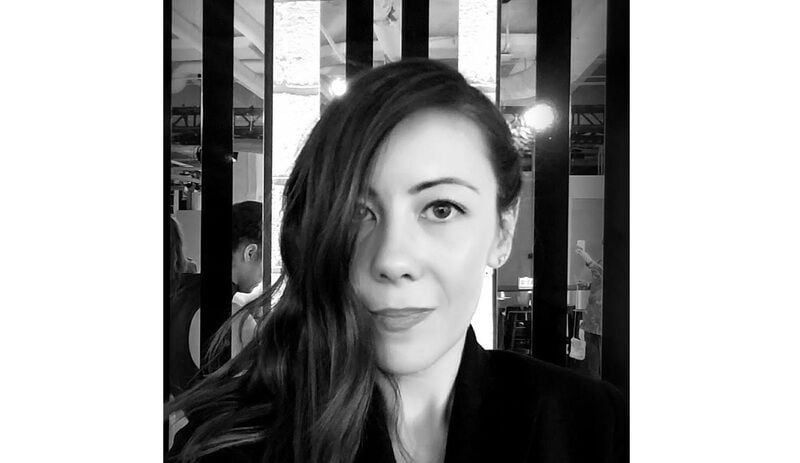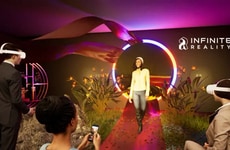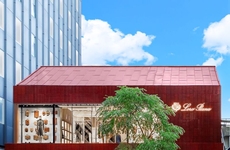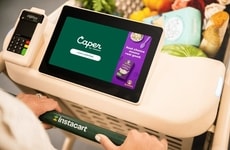Senior Art Director at Geometry Global, Veselina Angelova
Mishal Omar — March 6, 2017 — Business
Geometry Global is a brand activation company that works around the world. Trend Hunter recently spoke to the company's Senior Art Director, Veselina Angelova, in order to understand how Geometry Global is able to keep its ideas distinct and creative.
How does your team generate great ideas and do you have certain rituals to make creativity happen?
I don’t know if I’d call them rituals but lately we’ve been trying to get out of the office and immerse ourselves into the world around us and bring that into the room. For example, I recently went to the Cooper Hewitt and saw an exhibit that then inspired a new brainstorming tactic where you combine two completely random "triggers" to inspire a new idea. So imagine if you’re working on personal care, and you throw Beyoncé and augmented reality into the mix. What idea would that provoke? We’re just always trying to infuse a little bit of pop culture, or even current events and trends. It might be some crazy idea that we have to then bring down and ground a little, but it’s always great to start somewhere crazy and then bring it back.
I also think it’s important to establish a safe place where everyone feels free to imagine and create. A place where there is no judgment or criticism, where people feel free to express their ideas and have fun. That’s where the magic happens.
What are some barriers to innovation and how do you get around them?
Retailers have a lot of strict guidelines and sometimes that prevents us from putting the best idea out there and being able to execute it in the way that we want to. Sometimes we don’t have the freedom to think outside the box. I feel like everybody is struggling with it, which is crazy because if we’re all struggling with the same issue, why can’t we come up with a solution?
It’s funny how technology liberates us but also constrains us. For example, there’s so many things out there as far as tech, and when you think of the industry in retail and in shopper marketing, there’s just so much more that we could be doing. But retailers are not on the same level as technology, they’re not moving fast enough to address that. I think that’s one of the biggest barriers, the fact that we may have great ideas but the reality of the space doesn’t always allow us to execute them.
So how do you get around those barriers: I think for me it’s about educating ourselves and experiencing new technology – you can always sell something better if you’ve experienced it yourself. I love buying new tech and bringing it into the office, and letting the team play with it, and just seeing what that might do to the brainstorm, the ideas, to creativity in general.
Do you have specific rituals for resetting to be creative?
As of late, I’ve been into a lot of exercising and just trying to listen to my body, brain and heart. We don’t really turn off our brains; we leave our jobs and we still keep thinking about what we’re working on. I think it’s important to pause every day and be mindful of where you’re going and what you’re doing. So moving with a mindful process is a big thing for me. Just tuning into who you are and what your passions are is really important in this industry. I can always tell a project that I did with a lot of passion and a lot of heart versus another one that was just “get it done.” My big thing is tuning in and listening to my instincts, my heart and my passion
What are some examples of things you can do to create a culture of innovation?
It’s part education and part agency culture. I think that a company has the responsibility to feed both of those things into the teams and really foster that environment. So when I say part education – it could be conferences like Future Festival, CES or festivals that are known to be very inspiring and that promote innovation like SXSW. Being able to go to conferences and gain experiences is critical.
When I talk about culture, I think it’s really within all of us to create that environment and share inspiration and ideas because that leads to more inspiration and new ideas.
What do you think your industry will look like in the next 5-10 years?
I’m hoping that when it comes to the future of retail, we will see stores that are a lot more interactive and focus on the experience and the connection versus the transaction. As an example, I really love the Samsung 837 “Unstore” because you don’t go there to purchase a phone or appliances, you just go to get experiences and be part of a community. If you buy, it’s a bonus. Another example is Sephora, everybody loves going there and you’re never in a rush to go in and get out. You always spend a lot of time and you engage and immerse yourself in the experience. So the hope is that we will all eventually get there, that retailers will be more focused on the person than the purchase.
In advertising, I think content will be king. We’re in the business of storytelling, so that will never go away, and we just need to learn how to embrace technology and change the art of storytelling to make it even better. Through VR/ AR we have the ability to really make the world a much smaller place, and the fact that you can just put on VR goggles and be transported into a whole new world – I would love to see a lot more of that in the future. Empowering creativity through storytelling, creating these engaging experiences, and manifesting connections with people throughout the world is what I hope the future holds for our industry.
What's the most unconventional thing you have done to get inspiration?
It’s something I’ve been thinking about doing but have not done yet – bringing in speakers to inspire action and creativity. I’m trying to get that accomplished and not every project lends itself to it, but I think that starting with an amazing speaker can definitely dial up the energy in the room and spark new creative ideas.
I recently started an initiative with my manager to inspire the team to simply look around them because I believe inspiration is everywhere. Sometimes we get too stuck in our routines that we forget to look around. So we created an Instagram page and encouraged the team to contribute throughout the week with images that they find interesting. We now start every Monday just talking about these in hopes to inspire the week, the work, and everything we do. Everyone goes around the table, shares an image and talks about it. It’s always fun when people bring back images from their travels and we can get inspiration from places we’ve never been.
How does your team generate great ideas and do you have certain rituals to make creativity happen?
I don’t know if I’d call them rituals but lately we’ve been trying to get out of the office and immerse ourselves into the world around us and bring that into the room. For example, I recently went to the Cooper Hewitt and saw an exhibit that then inspired a new brainstorming tactic where you combine two completely random "triggers" to inspire a new idea. So imagine if you’re working on personal care, and you throw Beyoncé and augmented reality into the mix. What idea would that provoke? We’re just always trying to infuse a little bit of pop culture, or even current events and trends. It might be some crazy idea that we have to then bring down and ground a little, but it’s always great to start somewhere crazy and then bring it back.
I also think it’s important to establish a safe place where everyone feels free to imagine and create. A place where there is no judgment or criticism, where people feel free to express their ideas and have fun. That’s where the magic happens.
What are some barriers to innovation and how do you get around them?
Retailers have a lot of strict guidelines and sometimes that prevents us from putting the best idea out there and being able to execute it in the way that we want to. Sometimes we don’t have the freedom to think outside the box. I feel like everybody is struggling with it, which is crazy because if we’re all struggling with the same issue, why can’t we come up with a solution?
It’s funny how technology liberates us but also constrains us. For example, there’s so many things out there as far as tech, and when you think of the industry in retail and in shopper marketing, there’s just so much more that we could be doing. But retailers are not on the same level as technology, they’re not moving fast enough to address that. I think that’s one of the biggest barriers, the fact that we may have great ideas but the reality of the space doesn’t always allow us to execute them.
So how do you get around those barriers: I think for me it’s about educating ourselves and experiencing new technology – you can always sell something better if you’ve experienced it yourself. I love buying new tech and bringing it into the office, and letting the team play with it, and just seeing what that might do to the brainstorm, the ideas, to creativity in general.
Do you have specific rituals for resetting to be creative?
As of late, I’ve been into a lot of exercising and just trying to listen to my body, brain and heart. We don’t really turn off our brains; we leave our jobs and we still keep thinking about what we’re working on. I think it’s important to pause every day and be mindful of where you’re going and what you’re doing. So moving with a mindful process is a big thing for me. Just tuning into who you are and what your passions are is really important in this industry. I can always tell a project that I did with a lot of passion and a lot of heart versus another one that was just “get it done.” My big thing is tuning in and listening to my instincts, my heart and my passion
What are some examples of things you can do to create a culture of innovation?
It’s part education and part agency culture. I think that a company has the responsibility to feed both of those things into the teams and really foster that environment. So when I say part education – it could be conferences like Future Festival, CES or festivals that are known to be very inspiring and that promote innovation like SXSW. Being able to go to conferences and gain experiences is critical.
When I talk about culture, I think it’s really within all of us to create that environment and share inspiration and ideas because that leads to more inspiration and new ideas.
What do you think your industry will look like in the next 5-10 years?
I’m hoping that when it comes to the future of retail, we will see stores that are a lot more interactive and focus on the experience and the connection versus the transaction. As an example, I really love the Samsung 837 “Unstore” because you don’t go there to purchase a phone or appliances, you just go to get experiences and be part of a community. If you buy, it’s a bonus. Another example is Sephora, everybody loves going there and you’re never in a rush to go in and get out. You always spend a lot of time and you engage and immerse yourself in the experience. So the hope is that we will all eventually get there, that retailers will be more focused on the person than the purchase.
In advertising, I think content will be king. We’re in the business of storytelling, so that will never go away, and we just need to learn how to embrace technology and change the art of storytelling to make it even better. Through VR/ AR we have the ability to really make the world a much smaller place, and the fact that you can just put on VR goggles and be transported into a whole new world – I would love to see a lot more of that in the future. Empowering creativity through storytelling, creating these engaging experiences, and manifesting connections with people throughout the world is what I hope the future holds for our industry.
What's the most unconventional thing you have done to get inspiration?
It’s something I’ve been thinking about doing but have not done yet – bringing in speakers to inspire action and creativity. I’m trying to get that accomplished and not every project lends itself to it, but I think that starting with an amazing speaker can definitely dial up the energy in the room and spark new creative ideas.
I recently started an initiative with my manager to inspire the team to simply look around them because I believe inspiration is everywhere. Sometimes we get too stuck in our routines that we forget to look around. So we created an Instagram page and encouraged the team to contribute throughout the week with images that they find interesting. We now start every Monday just talking about these in hopes to inspire the week, the work, and everything we do. Everyone goes around the table, shares an image and talks about it. It’s always fun when people bring back images from their travels and we can get inspiration from places we’ve never been.
Trend Themes
1. Experiential Retail - Retail trends in the next 5-10 years are expected to move towards interactive experiences, community, and connection rather than just the transactional aspect of shopping, like the Samsung 837 “Unstore” or Sephora.
2. Empowering Creativity Through Technology - The advertising industry will focus on creating more engaging experiences and manifesting connections with people throughout the world through VR/AR and by learning how to embrace technology to make their art of storytelling even better.
3. Immersing Into the World Around Us - Brand activation companies and marketing teams can generate creative ideas by immersing themselves in events, experiencing new technology, listening to their body, brain, and heart, and looking at creative triggers from pop culture, personal care, and current trends.
Industry Implications
1. Retail - Retailers can use the trends like creating interactive experiences with their customer by promoting community and connection and utilizing technology such as VR/AR to enhance their storytelling.
2. Creative Agencies - Creative agencies can embrace technology to create more engaging experiences and storytelling and utilize conferences to inspire action and creativity.
3. Marketing - Marketing teams can generate more creative ideas by immersing themselves in events, listening to their body, brain, and heart, and looking at creative triggers from pop culture, personal care, and current trends.
6.7
Score
Popularity
Activity
Freshness






















